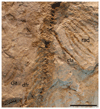Revision of Eocene electric rays (Torpediniformes, Batomorphii) from the Bolca Konservat-Lagerstätte, Italy, reveals the first fossil embryo in situ in marine batoids and provides new insights into the origin of trophic novelties in coral reef fishes
- PMID: 30210265
- PMCID: PMC6130837
- DOI: 10.1080/14772019.2017.1371257
Revision of Eocene electric rays (Torpediniformes, Batomorphii) from the Bolca Konservat-Lagerstätte, Italy, reveals the first fossil embryo in situ in marine batoids and provides new insights into the origin of trophic novelties in coral reef fishes
Abstract
The Eocene electric ray †Titanonarke Carvalho, 2010 from the Bolca Konservat-Lagerstätte, north-eastern Italy, is redescribed in detail based upon new material from recent excavations. This taxon exhibits a combination of features (large voids between the pectoral and the axial skeleton filled in life by electric organs, anteriorly directed fan-shaped antorbital cartilages, lack of dermal denticles, long prepelvic processes, and rounded basibranchial copula with a small caudal tab) that clearly supports its assignment to the order Torpediniformes. The analysis of new material also demonstrates that the previous apparent absence of typical narcinoid characters used to diagnose †Titanonarke was the result of taphonomic biases. †Titanonarke shares at least three synapomorphies (presence of a rostral fontanelle, low number of ribs, and rostral cartilage connected to the antorbital cartilage through lateral appendices) with the extant genera Benthobatis, Diplobatis, Discopyge and Narcine, with which it forms a clade (family Narcinidae) recognized herein as unquestionably monophyletic. Moreover, based upon a single specimen of †Titanonarke that exhibits a unique combination of morphometric and meristic features, a new species of Eocene numbfish †T. megapterygia sp. nov., is recognized. The presence of several specimens representing different ontogenetic stages of at least two species of numbfishes suggests a close association of this taxon with shallow-water habitats corresponding to coral reefs as hypothesized for the Monte Postale palaeoenvironment. The occurrence of a fossilized marine batoid embryo is reported here for the first time. Moreover, the analysis of the gut contents suggests that the dietary adaptations of †Titanonarke can be related, at least in part, to an opportunistic strategy in the context of abundant larger foraminifera in the Monte Postale palaeobiotope, suggesting that this kind of feeding mode, known to occur in present-day reefs, already was realized 50 million years ago.
Keywords: Chondrichthyes; Elasmobranchii; embryo; gut content; morphology; phylogeny.
Figures



















Similar articles
-
Revision of the Eocene 'Platyrhina' species from the Bolca Lagerstätte (Italy) reveals the first panray (Batomorphii: Zanobatidae) in the fossil record.J Syst Palaeontol. 2020 Jul 13;18(18):1519-1542. doi: 10.1080/14772019.2020.1783380. eCollection 2020. J Syst Palaeontol. 2020. PMID: 32939187 Free PMC article.
-
A synoptic review of the Eocene (Ypresian) cartilaginous fishes (Chondrichthyes: Holocephali, Elasmobranchii) of the Bolca Konservat-Lagerstätte, Italy.Palaontol Z. 2018;92(2):283-313. doi: 10.1007/s12542-017-0387-z. Epub 2017 Dec 30. Palaontol Z. 2018. PMID: 29875508 Free PMC article. Review.
-
Eocene sand tiger sharks (Lamniformes, Odontaspididae) from the Bolca Konservat-Lagerstätte, Italy: palaeobiology, palaeobiogeography and evolutionary significance.Hist Biol. 2017 Jun 22;31(2):102-116. doi: 10.1080/08912963.2017.1341503. eCollection 2019. Hist Biol. 2017. PMID: 30740006 Free PMC article.
-
Reappraisal of the Eocene whiptail stingrays (Myliobatiformes, Dasyatidae) of the Bolca Lagerstätte, Italy.Zool Scr. 2019 Mar;48(2):168-184. doi: 10.1111/zsc.12330. Epub 2018 Nov 28. Zool Scr. 2019. PMID: 30983683 Free PMC article.
-
'Fish' (Actinopterygii and Elasmobranchii) diversification patterns through deep time.Biol Rev Camb Philos Soc. 2016 Nov;91(4):950-981. doi: 10.1111/brv.12203. Epub 2015 Jun 23. Biol Rev Camb Philos Soc. 2016. PMID: 26105527 Review.
Cited by
-
Mosaic of plesiomorphic and derived characters in an Eocene myliobatiform batomorph (Chondrichthyes, Elasmobranchii) from Italy defines a new, basal body plan in pelagic stingrays.Zoological Lett. 2019 Apr 25;5:13. doi: 10.1186/s40851-019-0128-0. eCollection 2019. Zoological Lett. 2019. PMID: 31057944 Free PMC article.
-
A bizarre Eocene dasyatoid batomorph (Elasmobranchii, Myliobatiformes) from the Bolca Lagerstätte (Italy) reveals a new, extinct body plan for stingrays.Sci Rep. 2019 Oct 1;9(1):14087. doi: 10.1038/s41598-019-50544-y. Sci Rep. 2019. PMID: 31575915 Free PMC article.
-
Diversity, palaeoecology and palaeoenvironmental significance of the Eocene chondrichthyan assemblages of the Bolca Lagerstätte, Italy.Lethaia. 2021 Dec;54(5):736-751. doi: 10.1111/let.12436. Epub 2021 Jul 22. Lethaia. 2021. PMID: 35873368 Free PMC article.
-
A new Miocene skate from the Central Paratethys (Upper Austria): the first unambiguous skeletal record for the Rajiformes (Chondrichthyes: Batomorphii).J Syst Palaeontol. 2018 Oct 30;17(11):937-960. doi: 10.1080/14772019.2018.1486336. eCollection 2019. J Syst Palaeontol. 2018. PMID: 31156351 Free PMC article.
-
Egg preservation in an Eocene stingray (Myliobatiformes, Dasyatidae) from Italy.J Vertebr Paleontol. 2019 Apr 9;39(2):e1578967. doi: 10.1080/02724634.2019.1578967. eCollection 2019. J Vertebr Paleontol. 2019. PMID: 31709026 Free PMC article. No abstract available.
References
-
- Adnet S. Nouvelles faunes de selaciens (Elasmobranchii, Neoselachii) de l’Eocene moyen des Landes (Sud-Ouest, France). Implication dans la connaissance des communautes d’eaux profondes. Palaeo Ichthyologica. 2006;10:1–128.
-
- Adnet S, Cappetta H, Tabuce R. A Middle–Late Eocene vertebrate fauna (marine fish and mammals) from southwestern Morocco; preliminary report: age and palaeobiogeographical implications. Geological Magazine. 2010;147:860–870.
-
- Alcock A. A note on the deep-sea fishes, with descriptions of some new genera and species, including another probably vivparous Ophidioid. Annals and Magazine of Natural History, (Series 7) 1898;2:136–156.
-
- Alessandrello A. A revision of the annelids from the Eocene of Monte Bolca (Verona, Italy) Studi e ricerche sui giacimenti terziari di Bolca. 1990;6:175–214.
-
- Amalfitano J, Dalla Vecchia FM, Giusberti L, Fornaciari E, Luciani V, Roghi G. Direct evidence of trophic interaction between a large lamniform shark, Cretodus sp., and a marine turtle from the Cretaceous of northeastern Italy. Palaeogeography, Palaeoclimatology, Palaeoecology. 2017;469:104–121.
Grants and funding
LinkOut - more resources
Full Text Sources
Other Literature Sources
Molecular Biology Databases
